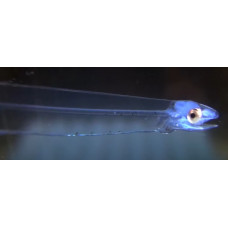Latin name
Conger myriaster
Other names
Conger myriaster
Identification
The lower jaw of these fishes is of moderate size, the teeth in the lower jaw are not exposed when closed. Above the upper lip there is a deep groove (appears curved). The teeth in the upper jaw are arranged almost in a single row. Lateral preanal pores 39-43. Vertebrae 142-148.
Features of fish fins
The dorsal and anal fins merge into the caudal fin. Pectoral fins are pointed.
Fish colouring
The head and body are covered with large white spots.
Distribution
Widespread in the northwestern Pacific Ocean off Japan, the Korean Peninsula, and the East China Sea.
Habitat
Demersal oceanodromous fish of temperate latitudes. Occurs at depths of 320-830 m. Common on sandy-silt substrates off Japan.
Size
Body length up to 1 m. Maximum reported age: 8 years.
Behavior
They are believed to feed on dead and rotting fish.
Food and feeding habits
These nocturnal predators feed primarily on fish, cephalopods and crustaceans.
Reproduction
Larvae are 120 mm long and are found in large numbers off the coast of Japan in early spring. Metamorphosis occurs from April to June at a length of about 130 mm and lasts about 20 days at 15°C. Length after metamorphosis is 83 mm.
Fishing
A valuable target of fisheries and mariculture in Japan.
Relationship with a person
Considered the tastiest of the Сongers. Can be aggressive towards humans.
| Classification | |
| Phylum | Chordata |
| Class | Actinopterygii |
| Squad | Anguilliformes |
| Family | Congridae |
| Genus | Conger |
| Species | C. myriaster |
| Features | |
| Conservation status | Least Concern |
| Habitat | Pelagic |
| Life span, years | 8 |
| Maximum body weight, kg | No information |
| Maximum length, cm | 100 |
| Sailing speed, m/s | No information |
| Threat to people | Edible |
| Way of eating | Predator |
Whitespotted conger
Tags: whitespotted conger



